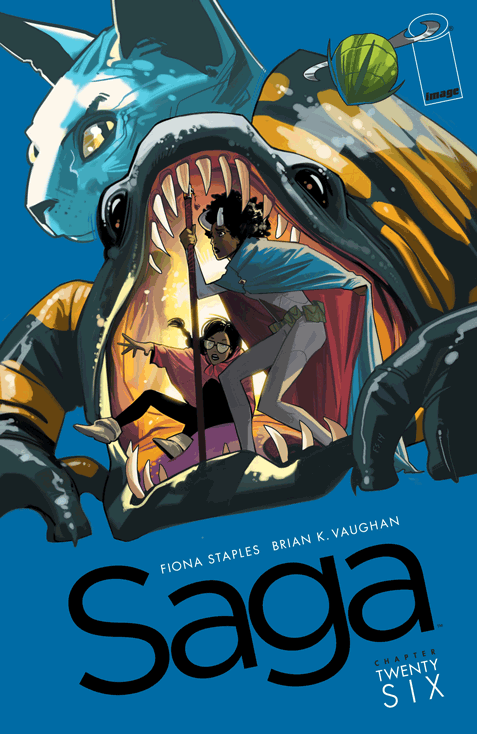The plot doesn't make much progress in "Saga" #26, but the issue is still rich with character development and Fiona Staples' gorgeous art. Each of the three stories is bursting at the seams, full of characters and complications; they're gathering toward their crisis points and so, though this issue feels like a pause, it seems like a pause on the teetering edge of a fall. Richly imagined and unafraid to break its characters and genre apart, "Saga" is a strong series even in its flyover issues.
Fiona Staples continues to be an international treasure. Her relentless, endless creativity pops up in the corners and character designs of every world in "Saga." Even when she's drawing characters that the reader has already seen, it's a pleasure to see how she treats their physicality. Staples' work shows real thought as to how a creature's shape affects its body language. Whether it's the sloppy hunching of the dragon mares, the light webbing of Julep's fingers or Quain giving a hug with his tiny hip-arms, all the characters move uniquely. There's always a lovely surprise or two in every panel. As a result, the world feels fuller and realer. That said, I'm certainly confused about how a TV head could give a blow job.
Staples' coloring is also rich and effective. Issues of "Saga" tend to open and close on dramatic notes, and those in medias res beginnings can only work if Staples establishes the setting immediately. Issue #26 opens in a hyper-bright convenience store with fuchsia and glowing yellow on the shelves and a lime-green sales clerk. Marko, standing in the aisle, wears olive green and black. It's immediately clear he's out-of-place on a foreign world.
For his part, Brian K. Vaughan juggles the many characters well. Each of the three storylines has four or more characters for him to pay attention to and more players keep appearing. Luckily, he can build on the work he's already done in the previous issues, but something has to give and, so far, it's the rebels. Quain, Julep and Zizz don't have distinct personalities yet and, while this is their first appearance, it does feel like something that Vaughan would have paid more attention to earlier in the series when he had more space. Their dialogue is primarily functional and, as a result, they feel more cluttering than threatening.
However, the main cast is still full of surprises and nuance. Vaughan finds tiny ways to add more layers to Alana and Marko as people and as parents, and the assassins, in-laws and animals that surround them also continue to develop. I'm optimistic that the rebels will undergo similar changes if they stick around.
Fonografiks' lettering continues to be clean and effective, from the iconic tremble of the "Lying" font to the neat, childlike scribble of Hazel's narration. In this issue, the dragons' bold, all-caps text is complemented by thicker borders on the word bubbles, and it feels like a grumpy club of words to match their anger and straightforwardness.
"Saga" #26 is slower piece of an excellent series, and I can't wait to see this work pay off in future issues.

